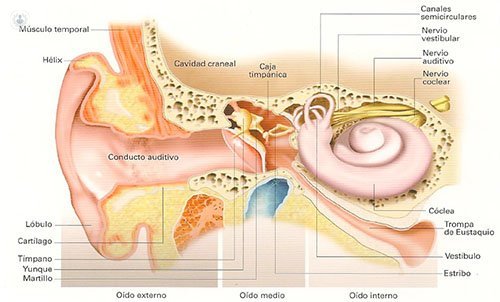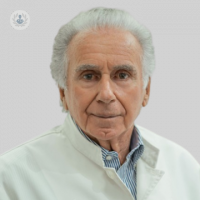Three generations of Otolaryngologists fighting deafness since 1945
Written by:One of the most common hearing loss is produced by otosclerosis, the most severe is the acoustic neuroma.

otosclerosis
It is a disease that calcify the stapes, the smallest huesecillo ear, producing a generally progressive deafness in both ears and can become very disabling for the patient. The ideal solution is surgical, Stapedotomy or Stapedectomy, an intervention of microsurgery and laser which can recover a good hearing between 95 and 99% of cases, as the case. It is more common in women than in men and is accented with pregnancies. In some cases they can cause very profound deafness.
Cochlear implant
If deafness is profound or total or a child born deaf, hearing can be obtained a good recovery with a Cochlear Implant consisting of an electronic presence in the inner ear (cochlea) complemented by external computerized processor similar to a hearing aid.
In 1985 we conducted for the first time in Spain a Cochlear Implant single channel called House 3M. Today implants are much more sophisticated and allow hearing recoveries in some cases near normal. If the implanted is a child born deaf also require a process of reeducation phonoaudiological the early years.
Suppurative otitis
It is a fairly common and often associated with a tympanic perforation or cholesteatoma and may be derived from catarrhal otitis, very common in children pathology.
In both cases plus medical treatment to cure the infection, may require surgical treatment to reconstruct the eardrum or ossicles, allowing in many cases a hearing recovery.
The implanted hearing aid
In some cases of deafness when the only solution is the headset (sonotone) generally in hearing loss called perceptual type caused by an injury to the nerve or the cochlea, it is also possible surgical implantation of a hearing aid specially designed and is totally hidden under skin, ie invisible.
In addition to the cosmetic benefit, because not seen, it allows to hear in situations where normal hearing can not be, ie, water sports, in the shower, sleeping, etc.. This itself needs to be surgically implanted.
Vertigo
A very common condition arising ear is the otologic vertigo, sometimes called Meniere's Disease. In principle it should be treated medically or with vestibular rehabilitation but if not resolved there are totally reliable surgical options. Sometimes Gentamicin injection or ear Cortisone can help improve the patient. If improvement is partial, or required to completely eliminate crises are very incapacitating vertigo that the best solutions are surgical, one is the Labyrinthectomy, but is indicated when the vertigo go associated with a significant hearing loss. The otologic vertigo is always accompanied by tinnitus and hearing loss, but if this is not very important the ideal solution is the vestibular neurectomy, ie, disconnect the balance organ inside the ear of the nerve centers which definitively eliminates the vertigo can keep hearing in most cases.
facial paralysis
Many facial paralysis have their origin in otologic problems. It is a very unpleasant aesthetically pathology and can be caused by ear infections, injuries from intense cold or tumors of the nerve itself or adjacent nerves, or viral origin.
In some cases treatment is medical, but if not resolved may require surgical treatment (decompression or repair of facial nerve) if the cause is a tumor of the nerve itself or an adjoining or auditory or vestibular nerve removal will be necessary if the paralysis it is important or has an intracranial growth.
If the result was a definitive facial paralysis exist nerve repair techniques with which you can get good results.
Acoustic neuroma
In the field of otoneurology, this condition is usually benign morphologically, but potentially serious tumor by the location. Is the formation of a tumor from the nerve of hearing or balance that can become very serious.
Clinical symptoms can start with tinnitus, hearing loss, dizziness, usually less violent than in Meniere's disease.
It is important early diagnosis is confirmed by MRI, because if the tumor is small and it is a young or middle-aged person, often can be removed while preserving hearing. If the tumor is diagnosed late and is larger (sometimes may happen that the lack of clinical symptoms does not allow early diagnosis) will be surgical solution. It can also be treated with radiosurgery although this does not remove the tumor and the patient will require a lifelong radiological control and often eventually must be operated with a considerable increase surgical risks. That is why we recommend this option in very old people or where a general condition does not allow affected undergo major surgery.
In all other cases the ultimate solution is the complete removal of the tumor before it starts to cause nerve symptoms or brain damage.


